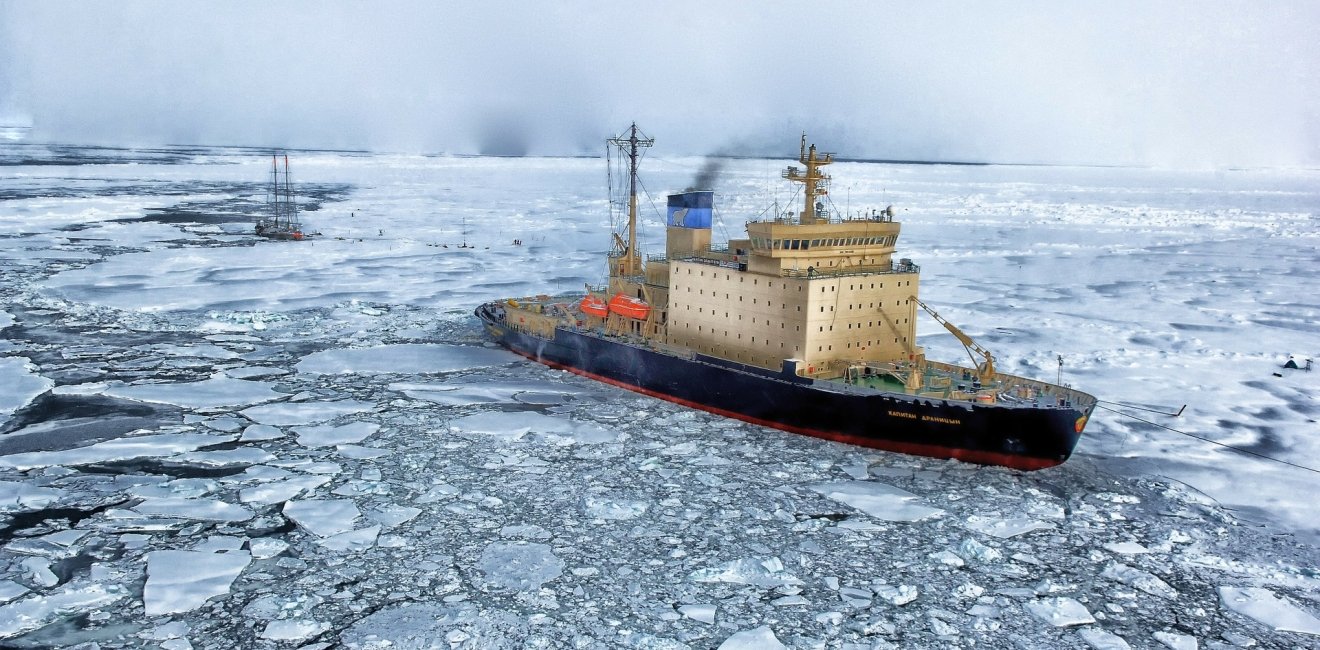
A blog of the Kennan Institute
BY MATHIEU BOULÈGUE AND KATARINA KERTYSOVA
Russia recently unveiled its new Arctic Strategy, which sets out its Arctic objectives and policy plans for the next fifteen years. Building on the 2008 Strategy, the 2020 document centers on the development of the Northern Sea Route (NSR) as “a globally competitive national transport corridor.”
To date, the development and day-to-day management of the NSR have been accompanied by fragmented and competing lobbying interests of the civilian energy sector, on the one hand, and the military on the other. This is particularly evident when it comes to influencing government investment in R&D and innovation. The matter is further complicated by the dual-use nature of capabilities and technologies deployed in the Russian Arctic, which essentially tie the energy sector and the military industry together.
While other Arctic states seek to optimize civilian-military cooperation in science and technology, Russia is beset by rivalry between civilian and military lobbies, which has prevented similar cooperation in the Russian Arctic. Moscow’s pursuit of dual-use technology development will either provoke further clashes or force the civilian and military actors to overcome their differences and collaborate in the Arctic, especially in the context of climate change and the implementation of Russia’s new Arctic Strategy, in effect until 2035.
Competing Lobbies in the Russian Arctic
In the Russian Arctic, a complicated mix of civilian and military actors vie for budget and attention from the Kremlin. These actors can be divided into two main lobbies: one civilian, which seeks cooperation with external actors, and one military, which views the Arctic as an area of great power competition.
The civilian lobby is based mainly in the energy industry (led by Gazprom, Novatek, and Rosneft), Rosatom, and NSR representatives. Entities in this lobby largely have a civilian and economic perspective on the Arctic and argue that Russia can become a relevant power in the European Arctic only if it cooperates with international partners in terms of investments and access to technology. Although international sanctions, in place since 2014, have weakened this logic, the “cooperation lobby” continues to dominate Arctic affairs today. The state corporation Rosatom has recently become one of the most influential actors in this lobby. In December 2018 the government delegated control of the NSR to Rosatom. Rosatom now operates the NSR infrastructure, its waters, and adjacent territories, and is in charge of granting access to Russian and foreign ships.
The military lobby oversees the securitization and remilitarization of the High North. It is represented by the Ministry of Defense, with the Northern Fleet the lead entity, followed by the National Security Council, the FSB, and representatives of the Russian military industry. Once instrumental in shaping Arctic policy in the mid-2000s, the security lobby seems to have recently lost some of its influence, to the benefit of the civilian lobby—with Rosatom leading the way. Furthermore, the critical lack of military ice class ships in the Russian armed forces leaves the Northern Fleet dependent on Rosatom’s fleet of civilian icebreakers to ensure passage along the NSR in ice conditions.
Why one lobby supersedes another depends on the Kremlin’s political priorities. With Yamal LNG and other energy projects in mind, President Putin might have decided to rebalance Russia’s approach in favor of a “soft civilianization” of the Russian Arctic altogether, especially when it comes to management of the NSR.
Dual-Use Technology Developments
In the Russian Arctic, distinguishing between capabilities primarily aimed at meeting societal challenges and those primarily aimed at meeting military threats against state security is difficult. Military capabilities and infrastructure clearly have dual uses, simultaneously fulfilling the country’s security needs and its socioeconomic plans.
The opening of the NSR led to a complete overhaul of forward bases and outposts along the Arctic Zone of the Russian Federation. Moscow opted to rebuild existing Soviet infrastructure and build new military bases from scratch along the NSR. New installations fundamentally serve both civilian objectives—search and rescue in the event of natural or industrial incidents, scientific and meteorological research, border monitoring and control, and overall domain awareness—and military objectives, ensuring the safety of the NSR and expanding the reach of the Northern Fleet.
The same dual-use logic applies to floating platforms in Arctic waters. In 2019, Russia began constructing an ice-strengthened self-propelled drifting platform for Arctic research. In addition to helping researchers study the Arctic seabed, the atmosphere, and the environment, the platform will also support naval and air operations of the Russian armed forces. Similarly, Russia’s first floating nuclear power station, the Akademik Lomonosov, is expected to provide electricity for civil and military uses alike.
While icebreakers and ice-capable ships are used for trade and rescue operations, they are also essential for military access and operations in the Arctic. The ongoing construction of two combat icebreakers can be interpreted as a way for the military to break free from its dependency on Rosatomflot, which operates Russia’s fleet of icebreakers and leases it to the navy when required.
The dual-purpose logic further applies to radio-electronic communications, satellites, and autonomous systems, especially surveillance drones, which serve the Northern Fleet and the energy companies alike.
A Future Research Agenda in Russian Arctic Affairs
Complex and tense civilian-military relations in decision-making make the Russian Arctic unique. The nature of Arctic-specific dual-use technology increasingly blurs the line between offensive and defensive capabilities.
Looking forward, understanding power plays between civilian and military actors in the Russian Arctic decision-making process is a paramount yet understudied field. Furthermore, the Arctic is the ideal place for the development and testing of modern capabilities, from autonomous systems to AI-assisted solutions, all stemming from Russia’s science and technology sector.
Civil-military rivalry and the increasing deployment of dual-use technologies need to be considered part of the same research agenda. A comparative assessment of innovative Arctic capabilities deployed by Russia and key NATO and Allied countries would be needed.
The opinions expressed in this article are those solely of the author and do not reflect the views of the Kennan Institute.
Authors

Consulting Fellow, Chatham House; Non-Resident Senior Fellow, Center for European Policy Analysis

Policy Fellow, European Leadership Network (ELN)

Kennan Institute
After more than 50 years as a vital part of the Wilson Center legacy, the Kennan Institute has become an independent think tank. You can find the current website for the Kennan Institute at kennaninstitute.org. Please look for future announcements about partnership activities between the Wilson Center and the Kennan Institute at Wilson Center Press Room. The Kennan Institute is the premier US center for advanced research on Eurasia and the oldest and largest regional program at the Woodrow Wilson International Center for Scholars. The Kennan Institute is committed to improving American understanding of Russia, Ukraine, Central Asia, the South Caucasus, and the surrounding region through research and exchange. Read more


Polar Institute
Since its inception in 2017, the Polar Institute has become a premier forum for discussion and policy analysis of Arctic and Antarctic issues, and is known in Washington, DC and elsewhere as the Arctic Public Square. The Institute holistically studies the central policy issues facing these regions—with an emphasis on Arctic governance, climate change, economic development, scientific research, security, and Indigenous communities—and communicates trusted analysis to policymakers and other stakeholders. Read more

Explore More in The Russia File
Browse The Russia File
Chechnya as a Model of Modern Russia

Russia’s Indigenous Communities and the War in Ukraine

Gas and Power in a Changing US–Russia Relationship

